
African artists create greater understanding by portraying life in China, an exhibition in Beijing reveals
In a Kansas schoolyard in 1979, alone in a crowd of children at play, Akonga Jonas Theodore made a discovery that would determine the course of his adult life.
Newly arrived in the United States, the 7-year-old from the Democratic Republic of Congo was isolated from the other children by barriers of language and culture.
In that lonely place, Akonga found his voice and his calling.
He spoke to his playmates not in the tongue of his African homeland, but in the scratchy whisper of pencil on paper, in the language of lines and shading.
"I took a pencil, and I drew what I wanted to say," Akonga remembers. "This is how I started using art to communicate with people."
It is a skill the now Beijing-based 41-year-old still uses.
"I did the same thing when I moved to China in 2003," he says.
Paints and brushes have become Akonga's communication tools along with English and Mandarin. Using art to transcend language and culture has become his profession, as well as his passion.
On Nov 22, his work appears as part of a groundbreaking exhibition in Beijing that documents through paintings, drawings and photographs the experiences of Africans living in China.
The driving force behind the exhibition, Beijing-based photographer and artist Njoku "Saint Jerry" Ajike, says he wants to reveal the largely untold journey that African immigrants have undertaken in China over the past decade.
When the 37-year-old Nigerian artist arrived in Beijing five years ago, he says he felt constrained by an erroneous stereotype that Africans were just out to make a buck any which way they could.
Few people, he says, realized what the African community was giving back to Beijing and the other Chinese cities where they had made lives and homes.
"The story of Africa in China is all hustle and bustle," he says. "This exhibition is a different view of Africans in China. It is archival, what Africans were able to discover here, what they built."
Believed to be the first African photographer to have his work featured in China's renowned Pingyao Photo Festival, in 2009 Njoku began publishing LensAfrik, a magazine focused on telling the African story in the world's second-largest economy.
The exhibition is in many ways the culmination of Njoku's years of work, and with a return to Africa on the cards, potentially his swan song.
Viewed through the prism of a lens, he says China and Africa have a lot to learn about each other.
"China thinks it knows Africa, but it does not know Africa," he says. "Africa thinks it knows China, but it does not know China."
Akonga and Njoku believe strongly that art is a way for both China and Africa to see the other from different perspectives, to find common ground, and to discover and relish differences.
"I use my paintings to make people think," Akonga says. "We can help the cultures understand each other better."
Akonga came to China after receiving a scholarship to study at the Central Academy of Fine Arts. He now has a studio space in Beijing and is close to completing a PhD.
"I draw on inspiration from Chinese characters," he says.
In one piece, he infused the Chinese character for "door" (men) with a layer of meaning from Africa.
"In my country we have an expression - to do things the right way, you have to get in or out the door, not the window."
One of the other paintings that clutter his workspace is a self-portrait. The Great Wall features on his shirt and in the background of the caricature. It is an exploration of retaining a sense of self and cultural identity while immersed in a foreign country.
Beijing artist Xie Fei, who has worked with Akonga in the past, is full of admiration for the African painter's tendency to infuse different cultural elements in his work.
"It is evident Akonga's works have a strong African flavor, in the bold colors he uses," Xie says. "But his work also combines African ethnic elements and Chinese elements in a way which I think is great. It makes the finished product modern and international."
Xie agrees with Akonga's belief that art is a means of transcending barriers of culture and language.
"Art is visual," he says, "and everyone can appreciate it and feel it. It is different from written languages that differ from nation to nation. Using art to connect China and Africa and help them understand each other better is a good way of communication."
Njoku's lens has captured Africans in China at work and play. In one series of studio shots, he explores the relationship between Africa and China using models and symbolism. An African woman coddles a beautiful Chinese baby. There is something there of the emerging relationship between mother and child, reminiscent of the birth of China-African relations, a reference to Njoku's resource-rich continent feeding China's industrial appetite and growth, and China giving something indefinable back to Africa.
Much of Njoku's photography features Chinese people being inducted into the wild and wonderful ways of traditional African dance and music. African immigrant turned Beijing music and arts promoter, Sam Ahadu, has often found himself framed by Njoku's lens.
Njoku says Ahadu is among a group of dedicated immigrants whose work in promoting African culture in China has broken down stereotypes and brought greater mutual appreciation and understating.
Ahadu is in turn full of praise for Njoku.
"When you bring cultures together, there's always misconceptions before everyone begins to appreciate each other's values and cultural attributes," says Ahadu. "The things Jerry and I do counter some stereotypes and misconceptions."
Akonga, like Njoku, is contemplating a return to his African homeland. Having brought something of Africa to China, both artists now hope to bring their understanding of China back to Africa.
"Sometimes the most helpful people are people like us," says Njoku. "We are a product of both cultures."
Akonga picks up a pen and begins to doodle on a notepad. He draws the men character that has featured so prominently in his work.
It looks like an open door. It looks both African and Chinese. It looks like a way into the future.
Mike Peters contributed to the story.
Contact the writers at josephcatanzaro@chinadaily.com.cn and chenyingqun@chinadaily.com.cn.
|
Above: Akonga combines multiple references from his Chinese experience in this self-portrait: a turbulent sky over Peking University, the Great Wall, and a land formation in Shandong province. Below: In this painting Akonga combines things he knows about the Democratic Republic of Congo and China, and the painting incorporates the Chinese character (gate or door). Mike Peters / China Daily |

|
Across the Lines. drawings and photos by njoku "Saint jerry" Ajike |

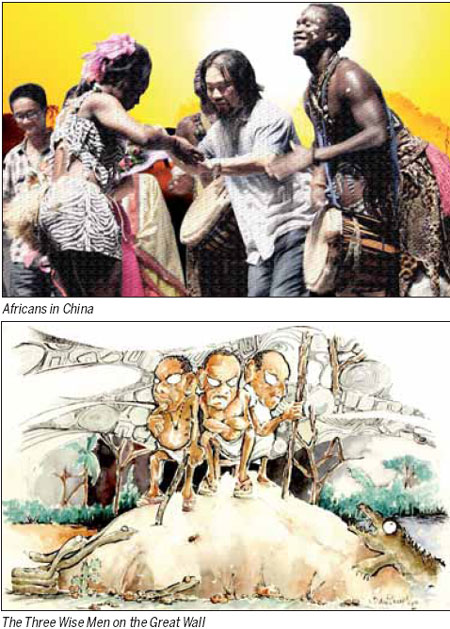
(China Daily Africa Weekly 11/22/2013 page24)

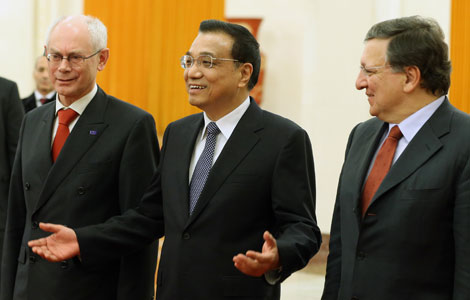
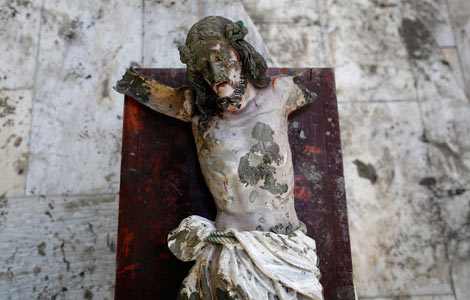
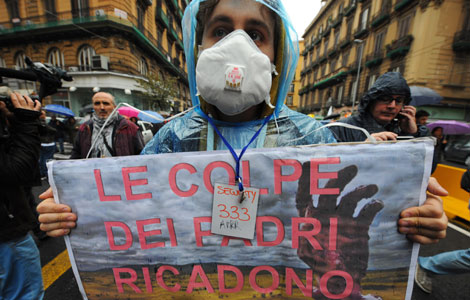




 IOC President: China's bidding offers a new approach for the Winter Games
IOC President: China's bidding offers a new approach for the Winter Games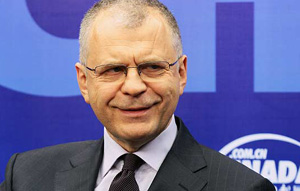 Reforms to benefit foreign investment
Reforms to benefit foreign investment Navy special - part 4: Fun times aboard the Peace Ark
Navy special - part 4: Fun times aboard the Peace Ark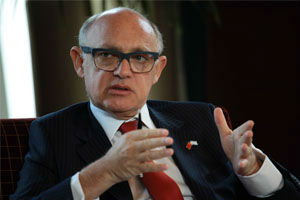 Argentine FM points to advantages of deeper ties
Argentine FM points to advantages of deeper ties